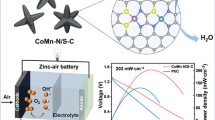Abstract
The electrochemical one-electron reduction (oxidation) of bipyridyl metal complexes ([Co(bipy)3]3+, [Cr(bipy)3]3+, [Fe(bipy)3]2+, [Ru(bipy)3]2+ (as well as Co(III) sepulcrate)) with water-soluble (thia)calix[4]arenes has been studied by means of cyclic voltammetry. It has been shown that [M(bipy)3]3+/2+ bind to (thia)calix[4]arenes via sulfonate groups of the upper rim. Oxidized forms bind stronger than reduced ones leading to reduction (oxidation) of half-wave cathodic shift. The effect of predominant stabilization of oxidized forms of metal complexes for carboxylated calix[4]arene is stronger than for thiacalix[4]arene (ΔΔG0 = − 7.8 ÷ − 12.5 and − 3.7 kJ/mol, respectively). The redox-switchable outer-sphere binding of Co(III) sepulchrate via lower rim of carboxylated calix[4]arene has been revealed using cyclic voltammetry. The binding constants of outer-sphere associates based on calix[4]arenes and unstable metal complexes ([Co(sep)]2+, [Ru(bipy)3]3+, [Co(bipy)3]2+) have been calculated for the first time using 1H NMR titration and cyclic voltammetry data.
Graphical abstract







Similar content being viewed by others
References
T. Horiuchi, J. Shiori, T. Hirao, Redox-switchable conjugated bimetallic ruthenium(II) complexes. Tetrahedron Lett. 48, 5970–5972 (2007)
V. Leeuven, T.C. Pijper, J. Areephong, B.L. Feringa, W.R. Browne, N. Katsonis, Reversible photochemical control of cholesteric liquid crystals with a diamine-based diarylethene chiroptical switch. J. Mat. Chem. 21, 3142–3146 (2011)
Y. Yildiz, S. Impellizzeri, E. Deniz, D. McCaughan, J.F. Callan, F.-I.M. Raymo, Supramolecular strategies to construct biocompatible and photoswitchable fluorescent assemblies. J. Am. Chem. Soc. 133, 871–879 (2011)
L.M. Moretto, T. Kohls, A. Chovin, N. Sojic, P. Ugo, Epifluorescence imaging of electrochemically switchable Langmuir–Blodgett films of nafion. Langmuir 24, 6367–6374 (2008)
J.M. Spruell, W.F. Paxton, J.-C. Olson, D. Benitez, E. Tkatchouk, C.L. Stern, A. Trabolsi, D.C. Friedman, W.A. Goddart, J.F. Stoddart, A push-button molecular switch. J. Am. Chem. Soc. 11, 11571–11580 (2009)
D. Canevet, M. Salle, G. Zhang, D. Zhu, Tetrathiafulvalene (TTF) derivatives: Key building-blocks for switchable processes. Chem. Commun. 17, 2245–2269 (2009)
K.C.-F. Leung, C.-P. Chak, C.-M. Lo, W.-Y. Wong, S. Xuan, C.H.K. Cheng, pH-controllable supramolecular systems. Chem. Asian. J. 4, 364–381 (2009)
P.G.A. Janssen, A. Ruiz-Carretero, D. Gonzales-Rodriguez, E.W. Meijer, A.P. Schenning pH-switchable helicity of DNA-templated assemblies. Angew. Chem. Int. Ed. 48, 8103–8106 (2009)
A.E. Kaifer, Supramolecular electrochemistry, (Wiley-VCH, Weinheim, 1999), p. 256
P.L. Boulas, M. Gomez-Kaifer, L. Echegoyen, Electochemistry of supramolecular systems. Angew. Chem. Int. Ed. 37, 216–247 (1998)
Y.-L. Zhao, W.R. Dichtel, A. Trabolsi, S. Saha, I. Aprahamian, J.F. Stoddart, A redox-switchable α-cyclodextrin-based [2]rotaxane. J. Am. Chem. Soc. 130, 11294–11296 (2008)
S. Dolder, S.-X. Liu, F. Le Derf, M. Salle, A. Neels, S. Decurtins, An original redox-responsive ligand based on a π-extended TTF framework. Org. Lett. 9, 3753–3756 (2007)
P.D. Beer, P.A. Gale, Anion recognition and sensing: the state of the art and future perspectives. Angew. Chem. Int. Ed. 40, 486–515 (2001)
A. Stepanov, Elektrochemicheskij electronnij perenos i inducirovannie im processi v sistemah na osnove n-sulfinatnih (tia)calix[4]arenov i ionov (komplexov) metallov (Electrochemical electron transfer and induced processes in systems based on p-sulfonated (thia)calix[4]arenes and metal ions (complexes), PhD thesis, Kazan, 2011, pp. 1-149
T. Matsue, T. Kato, U. Akiba, T. Osa, Electron-transfer reactions associated with host-guest complexation. Oxidation of ferrocenecarboxylic acid in the presence of β-cyclodextrin. J. Am. Chem. Soc. 107, 3411–3417 (1985)
A. Paillert, G. Herzog, D.W.M. Arrigan, Electrochemical activity of phenolic calixarenes. Electrochem. Commun. 5, 68–72 (2003)
P.L. Boulas, M. Gomez-Kaifer, L. Echegoyen, Electrochemistry of supramolecular systems. Angew. Chem. Int. Ed. 37, 216–247 (1998)
A. Niemz, V.M. Rotello, From enzyme to molecular device. Exploring the interdependence of redox and molecular recognition. Acc. Chem. Res. 32, 44–52 (1999)
P.D. Beer, P.A. Gale, G.Z. Chen, Electrochemical molecular recognition: pathways between complexation and signaling. J. Chem. Soc. Dalton Trans. 12, 1897–1909 (1987)
J. Alvares, Y. Wang, M. Gomez-Kaifer, A.E. Kaifer, Importance of intramolecular hydrogen bonding for preorganization and binding of molecular guests by water-soluble calix[6]arene hosts. Chem. Commun. 14, 1455–1456 (1988)
V. Burilov, Geterometallicheskiye komplexi i redox-perekluchaemie ystroistva na osnove proizvodnih sylfonatnih calix[4]arenov (Heterometallic complexes and redox-switchable devices based on derivatives of sulfonated calix[4]arenes, PhD thesis, Kazan, 2010, pp. 1–123
M. Wu, F. Jiang, M. Hong, Inclusion of p-Sulfonatothiacalix[4]arene and Its metal complexes. Chem. Rec. 9, 155–168 (2009)
N. Iki, T. Horiuchi, H. Oka, K. Koyama, N. Morohashi, C. Kabuto, S. Miano, Energy transfer luminescence of Tb3 + ion complexed with calix[4]arenetetrasulfonate and the thia and sulfonyl analogue. The effect of bridging groups. J. Chem. Soc. Perkin Trans. 2, 2219–2225 (2001)
Y. Wang, S. Mendoza, A.E. Kaifer, Electrochemical reduction of cobaltocenium in the presence of β-cyclodextrin. Inorg. Chem. 37, 317–320 (1998)
C.M. Cardona, A.E. Kaifer, Asymmetric redox-active dendrimers containing a ferrocene subunit. Preparation, characterization, and electrochemistry. J. Am. Chem. Soc. 120, 4023–4024 (1998)
J. Ferguson, C.J. Hawkins, L.A.P. Kane-Maguire, H. Lip, Absolute configurations of 1,10-phenantroline and 2,2-bipyridine metal complexes. Inorg. Chem. 8, 771–780 (1969)
F.H. Brustall, R.S. Nyholm, Magnetic moments and bond types of transition-metal complexes. Studies in co-ordination chemistry. Part XIII, 3570–3579 (1952)
N. Iki, T. Fujimoto, S. Miyano, A new water-soluble host molecule derived from thiacalixarene. Chem. Lett. 27, 625–626 (1998)
A. Casnati, Y. Ting, D. Berti, M. Fabbi, A. Pochini, R. Ungaro, D. Sciotto, G.G. Lombardo, Synthesis of water soluble molecular receptors from calix[4]arenes fixed in the cone conformation. Tetrahedron 49, 9815–9822 (1993)
E. Merck, Methodes d’Analyses Complexometriques par les Titriplex. (Darmstadt 1964)
Z. Galus, Teoretyczne podstawy elektroanalizy chemicznej (Warszawa, 1971), pp. 1–552
Author information
Authors and Affiliations
Corresponding author
Electronic supplementary material
Below is the link to the electronic supplementary material.
Rights and permissions
About this article
Cite this article
Stepanov, A., Yanilkin, V., Mustafina, A. et al. Electrochemical properties of outer-sphere associates of bipyridyl and sepulchrate metal complexes with (thia)calix[4]arenes. J IRAN CHEM SOC 15, 2251–2258 (2018). https://doi.org/10.1007/s13738-018-1414-z
Received:
Accepted:
Published:
Issue Date:
DOI: https://doi.org/10.1007/s13738-018-1414-z




